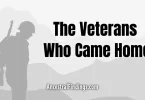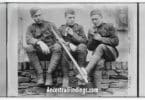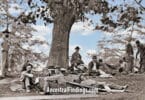War has a way of pausing life. Plans are put on hold. Relationships are delayed. Young people grow older quickly. And when the fighting ends, the urge to settle down often comes fast — sometimes with someone they wrote to during the war, met while deployed, or reunited with after years apart.
That’s why so many families — maybe even yours — began with a marriage that happened after the war.
For family historians, these post-war marriages can unlock stories that explain late-in-life first children, sudden name changes, cross-country moves, or entire branches of the family tree that appear unexpectedly. These unions were often the beginning of second lives — built in peacetime, but forged in the shadow of war.
Why So Many Veterans Married Later
Marriage after military service wasn’t just about romance — it was often about practicality and timing. Many men waited until they returned home before committing to a spouse. They wanted to be financially stable, physically present, or simply sure they’d survive.
Some had sweethearts waiting for them. Others met someone new during recovery, resettlement, or travel. And some married quickly — swept up in the relief of survival and the excitement of a fresh start.
The result? A noticeable wave of marriages happened after the war ended — especially after the Revolutionary War, Civil War, WWI, and WWII.
These marriages often began a brand-new chapter — one that’s easy to miss if you’re only looking for wartime records.
Where to Start the Search
If you’re looking to trace a marriage that happened after military service, start with the basics, but be ready to dig into:
- County marriage records (especially in counties near military hospitals or training centers)
- Newspaper wedding announcements, often published weeks after return from service
- Church records, especially if the veteran returned to a different denomination or married in a new town
- Pension files, which often include marriage certificates, especially if the veteran or widow applied years later
- State veteran questionnaires, which sometimes asked about marital status and number of children
Also look for sudden name appearances in the 1940 or 1950 census — a wife or child who wasn’t there in 1930. Or use city directories to identify new households and first-time listings of a married couple under one roof.
War Brides and International Love Stories
Some veterans married overseas — a common occurrence after both World Wars. Known as war brides, these women often came from England, France, Germany, Italy, the Philippines, Japan, or Australia.
If your family has a grandmother or great-grandmother who spoke with an accent or kept foreign customs alive, she may have been a war bride. These marriages often involved immigration paperwork, sponsorship, and ship passenger lists.
Look for:
- Alien registration forms
- Naturalization paperwork tied to military service
- Ship manifests or visa records, especially 1945–1947
- Photos with overseas locations noted on the back
War bride stories are often preserved in family photo albums, letters, or oral histories. If your family has one, dig into it — these unions often added vibrant and unexpected elements to American family stories.
Why the Marriage Timing Matters in Genealogy
When you’re building a family tree, you usually start with birthdates. But marriage dates can be just as telling — especially if they happen after wartime.
For example:
- A man born in 1892 who doesn’t marry until 1920 may have served in WWI.
- A man born in 1840 who marries in 1866 likely served in the Civil War.
- A woman who marries in her 30s in 1946 might’ve been a WAC or WAVES service member.
These gaps often point directly to military service — and help explain why children were born later, why there’s a break in the census trail, or why a first spouse isn’t mentioned in earlier records.
Veterans and Second Marriages
Not all post-war marriages were firsts. Some veterans lost spouses during wartime — to illness, hardship, or long separation. Others divorced shortly after returning home due to trauma or changed expectations.
If your ancestor had more than one marriage, try to:
- Check all marriage records by name in the county, even if you only know of one
- Look for divorce filings, which often list property, children, and reasons for separation
- Watch for children from earlier marriages, sometimes listed as stepchildren in census records
- Use DNA matches to identify half-siblings or unexpected branches
Second marriages after war can reshape the entire tree — especially when children from the first marriage are lost to time or absorbed into a blended family.
Cultural Expectations and the Push to Marry
After every major war, there’s a cultural push to “return to normal.” For men, that often meant settling down, finding work, and starting a family. For women, especially after WWII, it often meant leaving work and marrying — even if they had served or led independent lives during the war.
These pressures sometimes led to hasty marriages, early pregnancies, or long-term partnerships that didn’t last. It also produced a generation of “silent” stories — people who stayed married but lived apart, raised families under stress, or never really reconnected with the person they were before the war.
As you research, treat these marriage records not just as legal facts, but as emotional turning points. They reflect both hope and hardship — and often explain what came next.
Tips for Tracing Post-War Marriage Stories
- Search local newspapers for returning soldier wedding announcements
- Look in military pension files for late-added marriage certificates
- Review state archives for soldier home or hospital marriage registries
- Explore foreign archives if a spouse was born overseas
- Use DNA to confirm connections when paper records are missing or inconsistent
A Family Born in Peacetime
Some of the most beautiful family stories began in the quiet years after war. A veteran came home, started over, and married someone who helped rebuild a life. Together, they raised a family — maybe your branch of the tree.
And while the marriage happened in peacetime, its roots were in sacrifice, survival, and resilience.
If you’re tracing your family’s beginnings, don’t forget to look right after the uniforms came off.
That’s often when the story truly begins.






